Looking for a simple Turkish dessert? Try irmik helvasi (semolina halva)! Just semolina, pine nuts, sugar and water come together in one pan to make a sweet treat loved for generations in Turkey.

In Turkey, irmik helvasi is more than just a dessert. It’s often made for special occasions, from family gatherings and celebrations to moments of remembrance after someone passes away. That’s why it carries both sweetness and a sense of tradition.
Everyone in Turkey has a memory of irmik helvasi and their grandma, who is usually the halva expert in the family. It’s one of those recipes passed down through generations, often learned simply by watching her make it in the kitchen.
About The Ingredients
Turkish semolina helva is really easy to make. You only need a few ingredients.

Semolina: Known as irmik in Turkish. It is a type of textured semolina flour made from durum wheat. Use extra coarse semolina for this recipe.
Oil: We use light olive oil, but you can use vegetable oil or sunflower oil too. Authentic semolina helva is made with butter instead of oil. So, you can do this as well. But for a lighter taste (which is what we prefer), we use olive oil.
Pine Nuts: Traditional irmik helvasi is made using pine nuts but you can also use walnuts or almonds.
Sugar: We use granulated white sugar.
Lemon zest: It is completely optional and not very traditional. But we do like the zesty fresh flavor it adds to the semolina.
Cinnamon powder: We use it as a garnish for the topping of semolina halva.
How To Make Irmik Helvasi
You can find the full instructions in the recipe card at the bottom of this post.
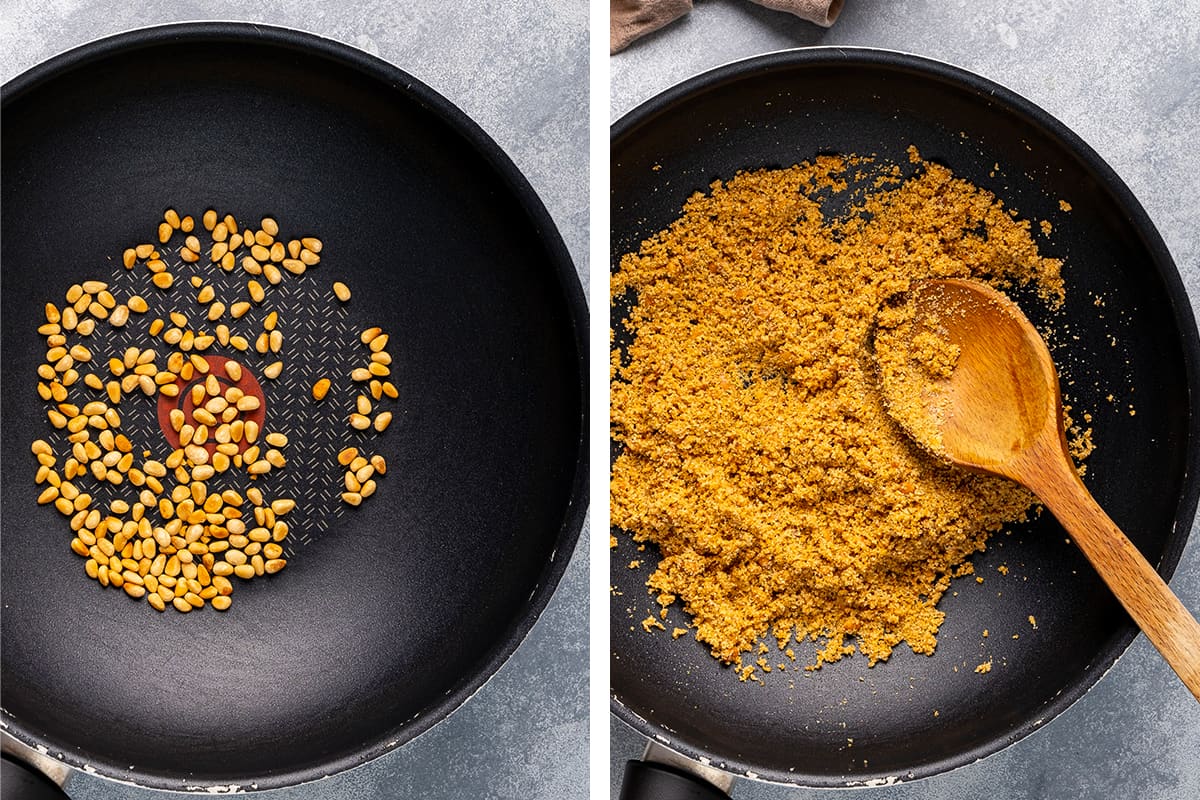
Here’s the quick idea of how we make irmik helvasi: First, toast the pine nuts until golden, then add semolina and cook until it turns golden brown and smells nutty.
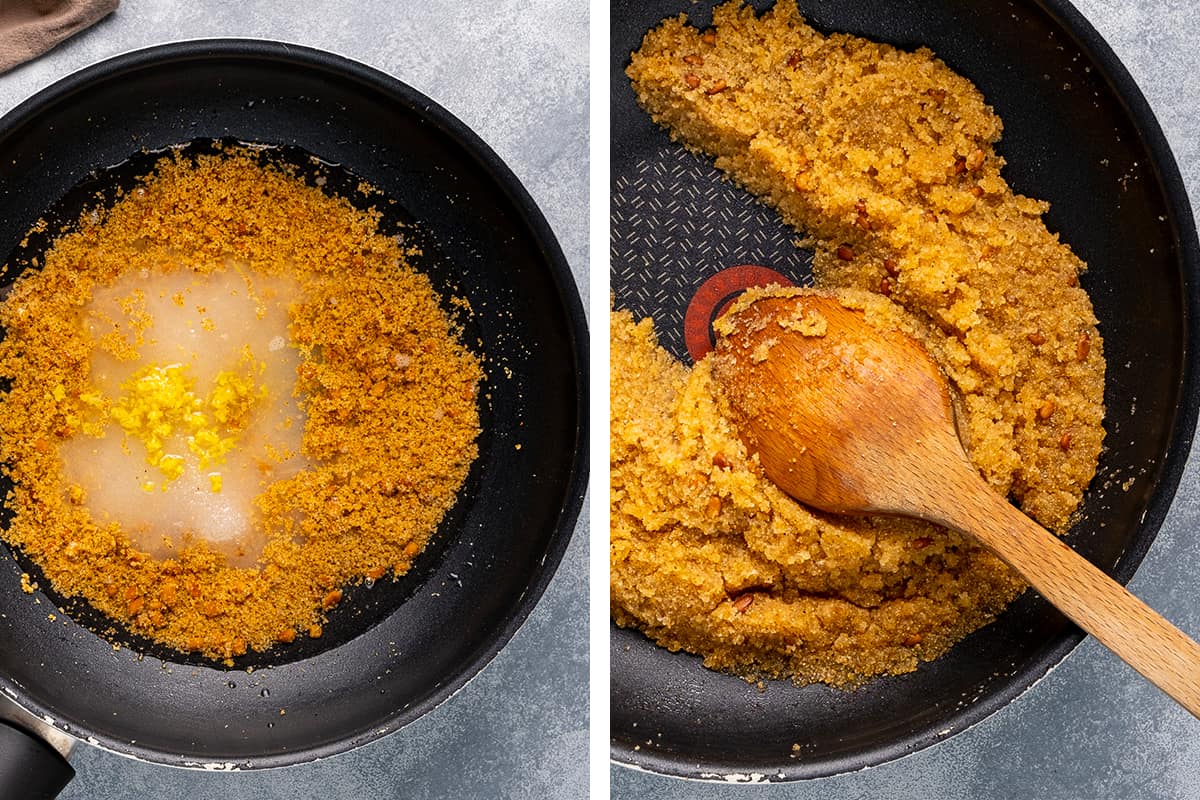
Stir in sugar and water (plus lemon zest if you like). Let it simmer gently until the liquid is absorbed, then rest it for a bit. That’s it, all done in one pan!
Optional Add-Ins
Here are a couple of ingredients you can add to this easy semolina dessert.
Raisins or currants: Add about ½ cup right before pouring the water into the pan. They bring a gentle sweetness and chewy texture.
Ground Pistachio: A popular garnish for serving irmik helvasi.
Cheese: In Hatay (Antakya) city of Turkey, a cheesy version of irmik helvasi is very popular. It’s similar to Turkish künefe, made with an unsalted melting cheese. The traditional cheese is hard to find abroad, but shredded mozzarella works as a substitute. To try this version, add about ½ cup mozzarella right after the syrup is absorbed. Stir, cover, let it rest for 10–15 minutes, and serve warm.
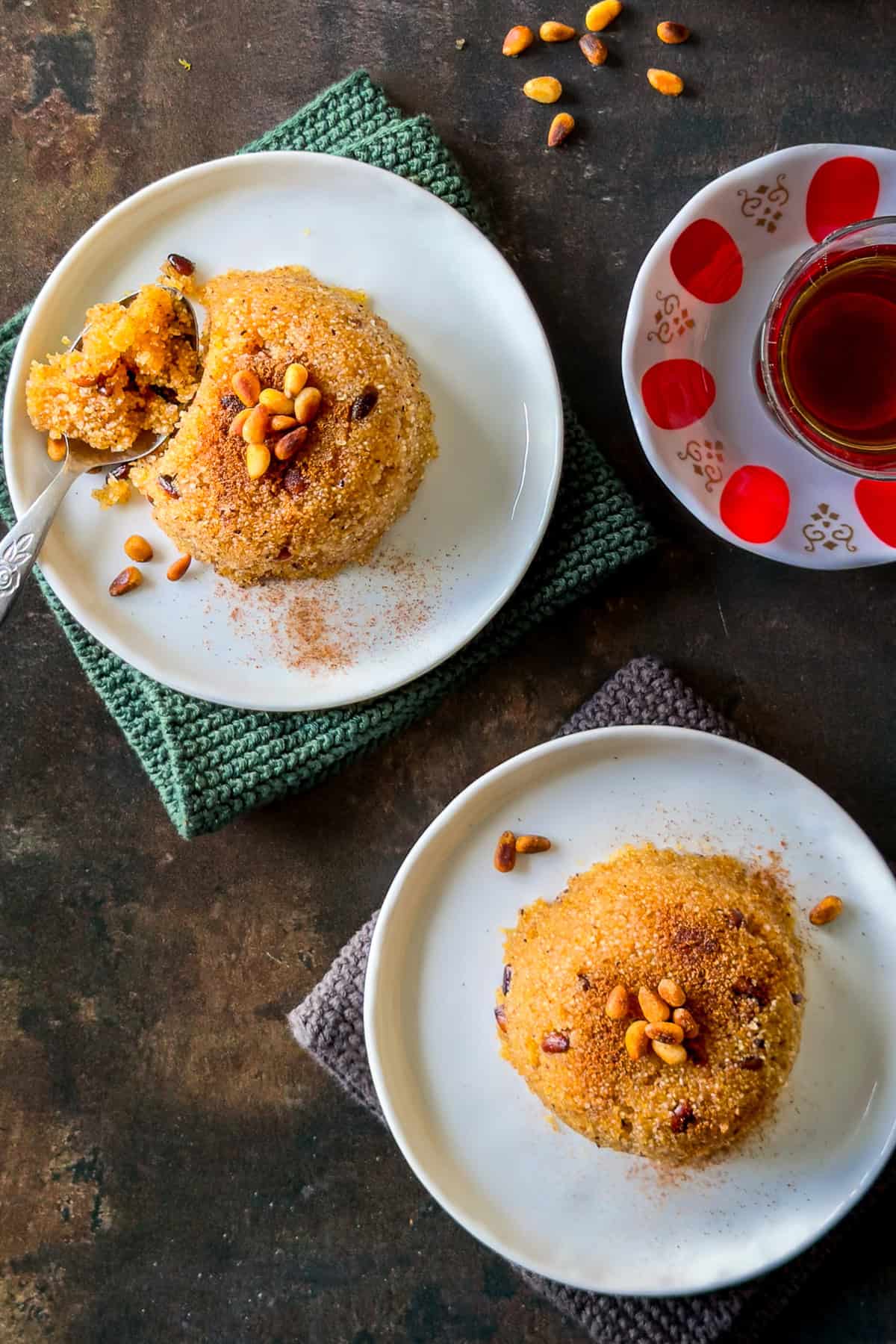
Serving Suggestions
Traditionally, irmik helvasi is served in small bowls or shaped into domes.
We like to sprinkle a little cinnamon on top, but that’s totally up to you.
The most classic way to enjoy it is with a cup of Turkish tea or coffee on the side. And if you want to take it to the next level, add a scoop of ice cream (dondurma).
Storage
You can store this semolina halva at room temperature for one day. If you store it properly inside the fridge, it will even last up to a week!
Keep it inside an airtight container to help preserve its flavor and texture.
Do not freeze halva. It doesn't keep well, and won't be as good as when made fresh.
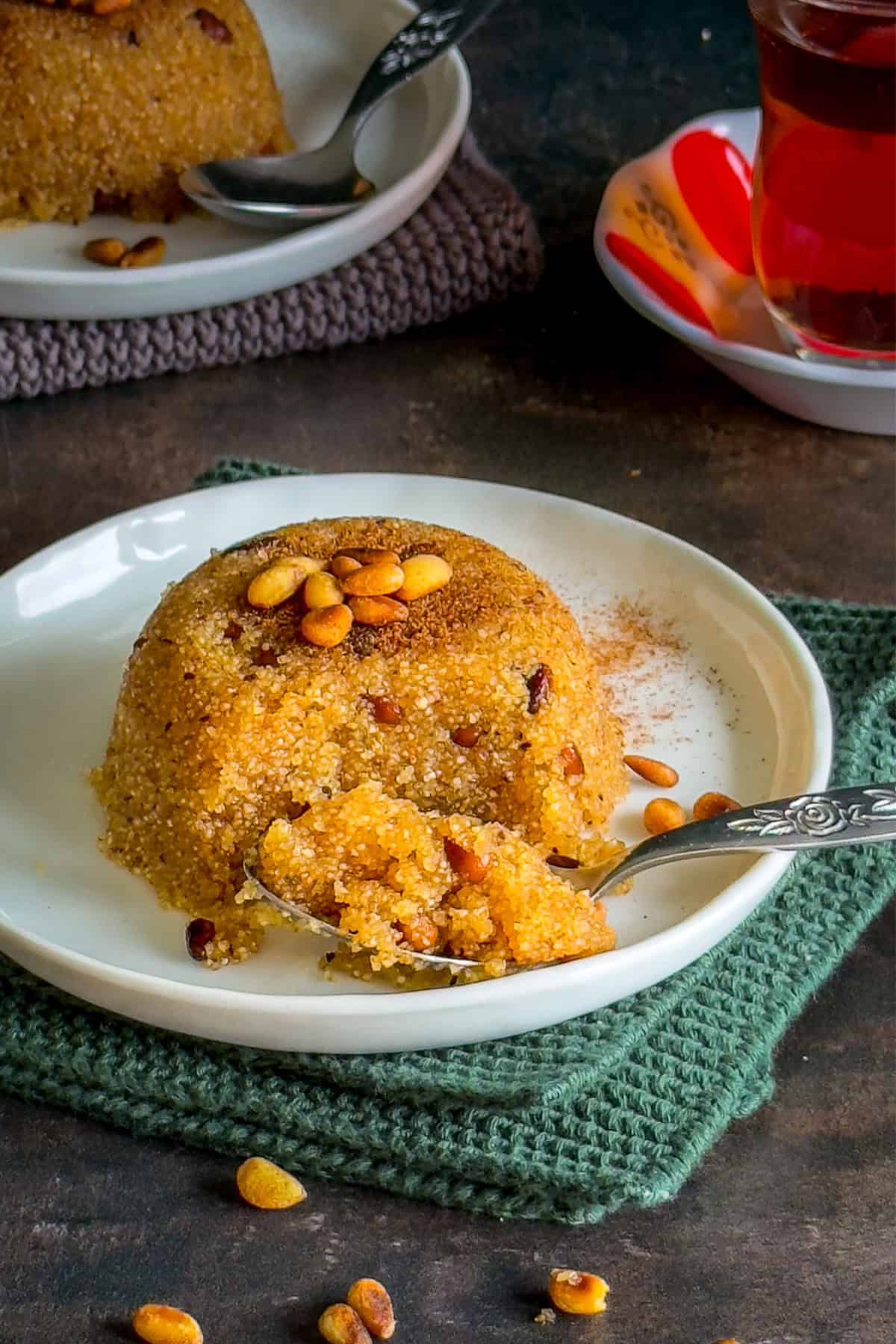
Our Tips
- Keep an eye on the pan at all times. Semolina can burn quickly once it heats up. Stir constantly until it turns golden or light brown. Just follow the steps and cooking times in the recipe card below.
- Be careful when adding the water. Since the semolina in the pan is very hot, it can splatter and burn you.
- Let the semolina halva rest for 15 minutes before serving. This step helps it develop a better texture and flavor.
More Turkish Desserts
As always: If you make this recipe, let us know what you think by rating it and leaving a comment below. And post a pic on Instagram too—tag @give_recipe so we can see!
Sign up for the FREE GiveRecipe Newsletter to get the new recipes into your inbox! And stay in touch with us on Facebook, Pinterest, YouTube and Instagram for all the latest updates.
📖 Recipe

Irmik Helvasi (Turkish Semolina Halva)
INGREDIENTS
- 3 tablespoons pine nuts
- 80 ml olive oil
- 200 grams semolina extra coarse
- 1 teaspoon lemon zest optional
- 225 grams sugar
- 320 ml water
- ½ teaspoon cinnamon optional
INSTRUCTIONS
- Toast the pine nuts: Heat a non-stick pan over medium-high heat and add the pine nuts. Toast them, stirring constantly, until they turn lightly golden. This usually takes about 3–4 minutes. At first, it might look like nothing is happening, but once they start changing color, they brown quickly, so don’t leave the pan unattended.
- Cook the semolina: Add the olive oil and semolina into the pan. Cook over medium heat, stirring all the time, until the semolina turns golden and smells nutty. This will take about 8 minutes.
- Add flavorings and water: Stir in the lemon zest (if using) and sugar. Then carefully pour in the water. The semolina will be very hot at this stage, and if you add the water too quickly it can splatter and burn you. Give it a quick stir, cover the pan, and let it come to a boil.
- Simmer: As soon as it starts boiling, lower the heat to the minimum and let it simmer until the liquid is fully absorbed, about 3–4 minutes. You can give it a gentle stir once or twice while it cooks.
- Rest: When all the water is gone, remove the pan from the heat. Cover it with a lid and let the halva rest for 15 minutes.
- Shape or serve: Spoon it into bowls and serve. If you want the traditional dome shape, use a small porcelain or glass bowl (other materials don’t work well because the halva sticks). Lightly wet the inside of the bowl, fill it with semolina halva, press it down firmly, then place a small plate on top and flip it over.
- Finish and enjoy: Serve warm or at room temperature. Sprinkle with cinnamon right before serving.
NOTES
- Use extra coarse semolina, NOT fine semolina.
- If you are using butter instead of oil, let it melt in the pan before adding semolina.
- You shouldn’t leave the pan when cooking this helva. After reaching a certain temperature in the pan, semolina might burn very quickly. So you should keep an eye on it and cook stirring constantly. We want the semolina to get golden or very light brown. If you follow the steps with their time in the recipe card below, everything will be fine.
- Be careful when pouring water into the pan once the semolina in it gets golden. As the pan is really hot, water might spill.
- Don’t serve it before letting the helva sit for 15 minutes. The texture will get better and the flavors will bend better.
NUTRITION
Nutrition information is automatically calculated, so should only be used as an approximation.
ADDITIONAL INFO
You might also like:


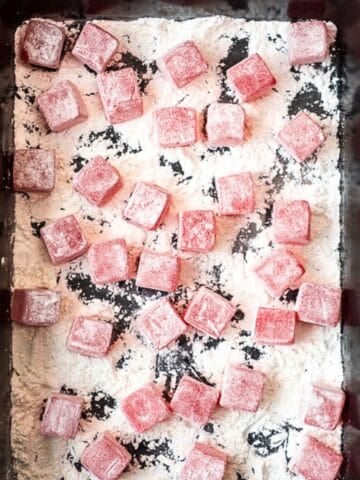




Ozlem says
I tried your semolina halva recipe today and it turned out absolutely delicious! The instructions were very clear and easy to follow. My family loved it so much. Thank you, Zerrin and Yusuf, for sharing such a wonderful recipe with us.
Zerrin & Yusuf says
Hi Ozlem! We’re so happy to hear that you and your family enjoyed it! Thank you for trying our recipe and for your lovely words. It means a lot to us. 🥰
Denise says
This is how I exactly like semolina halva. With oil and pine nuts. Thank you for the recipe!
Zerrin & Yusuf says
Hi Denise,
Happy to hear that 🙂
Mina Joshi says
Wow - another dish we Indians love and make. This semolina halva is one of my favourites, I make it very similar to you but have never added lemon zest.
Wendy says
This looks lovely, Zerrin! I have a question about the word "halva". Does it mean something? The middle eastern halva I am used to is made with sesame seeds and is a very firm candy. This sweet reminds me of the semolina filling in the Greek pastry galaktoboureko (my personal favorite).
Zerrin says
Hi Wendy! Halva is the name we use for desserts made with flour, semolina or sesame seeds. In its origin, halva was used in place of the word dessert. Now we have 3 types of halva. Tahini halva, one you know, which is very firm; semolina halva and flour halva. Never heard of galaktoboureko, must search for it!
Reeni says
This looks so elegant and special Zerrin! Especially so when made by Grandmas. I like the mix of flavors you infused into it - irresistible!
Zerrin says
Thank you Reeni! Grandmas always know the best! Lemon zest and currants were definitely perfect and I guess my grandma would be proud of me!
Ilke says
Nice looking halva! So inviting. We used to make it in the middle of the night when we were back in college and pulling all nighters. No wonder we stayed up till morning with that sugar rush 🙂
Zerrin says
I don't know how, but we crave for it at nights too! I'm sure my neighbors would get angry with me if I made these at night. Its smell becomes more tempting in the middle of night!
Rosa says
A delicious treat! That is something I'll have to make very soon...
Cheers,
Rosa
Chris at Hye Thyme Cafe says
Funny timing - I have only ever had the pine nut version (known to me as Imrig Halva), but I was also thinking about a new version ... I received a sample of chocolate Cream of Wheat in the mail, and that was the first thing I thought of. Trying a chocolate version - maybe with almonds. I love the idea of the currants in this one, and that would give me something to use them in besides scones and stuffed grape leaves. 🙂
Zerrin says
Chris, chocolate version of irmik halva sounds great! Almonds would be a perfect addition too!
TasteofBeirut says
Very pretty and so delicious! I like this with cheese interlaced with it!
Zerrin says
Joumana, I remember now that I ate a kind of semolina dessert with unsalted cheese at a kebab restaurant, and it was fantastic! I must search for its recipe now!